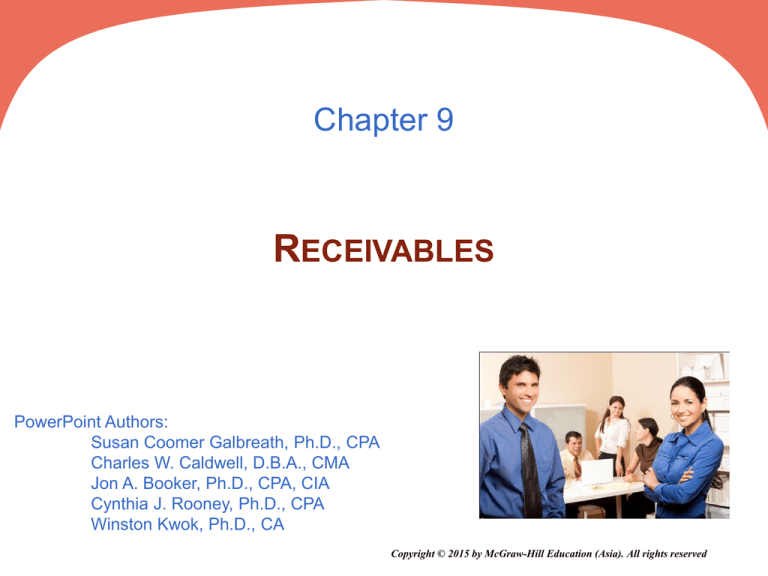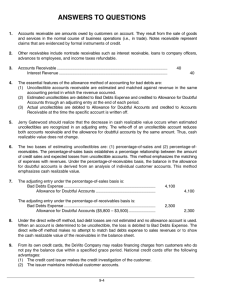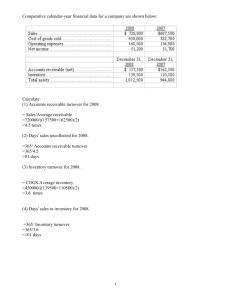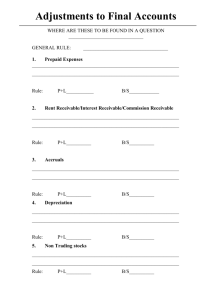
Chapter 9
RECEIVABLES
PowerPoint Authors:
Susan Coomer Galbreath, Ph.D., CPA
Charles W. Caldwell, D.B.A., CMA
Jon A. Booker, Ph.D., CPA, CIA
Cynthia J. Rooney, Ph.D., CPA
Winston Kwok, Ph.D., CA
Copyright © 2015 by McGraw-Hill Education (Asia). All rights reserved
9- 2
C1
ACCOUNTS RECEIVABLE
A receivable is an amount due from another party.
This graph shows recent
dollar amounts of
receivables and their percent
of total assets for four wellknown companies.
A company must also maintain a separate account for
each customer that tracks how much that customer
purchases, has already paid, and still owes.
9- 3
C1
SALES ON CREDIT
On July 1, TechCom had a credit sale of $950 to
CompStore and a collection of $720 from RDA
Electronics from a prior credit sale.
9- 4
C1
SALES ON CREDIT
9- 5
C1
CREDIT CARD SALES
Advantages of allowing customers to use
credit cards:
Customers’
credit is
evaluated by
the credit card
issuer.
Sales increase by
providing purchase
options to the customer.
The risks of extending credit
are transferred to the credit
card issuer.
Cash collections
are quicker.
9- 6
C1
CREDIT CARD SALES
On July 15th, TechCom has $100 of credit card
sales with a 4% fee, and its $96 cash is
received immediately on deposit.
9- 7
C1
CREDIT CARD SALES
If instead TechCom must remit electronically the credit card
sales receipts to the credit card company and wait for the $96
cash payment, we will make the first entry on July 15, and the
second entry on July 20, when the cash is received.
9- 8
C1
INSTALLMENT ACCOUNTS RECEIVABLE
Amounts owed by customers from credit sales for
which payment is required in periodic amounts over
an extended time period. The customer is usually
charged interest.
Ford Motor Company reports
more than $75 billion in
installment receivables.
9- 9
P1
VALUING ACCOUNTS RECEIVABLE
Some customers may not pay their account.
Uncollectible amounts are referred to as bad debts.
There are two methods of
accounting for bad debts:
Direct Write-Off Method
Allowance Method
9- 10
P1
DIRECT WRITE-OFF METHOD
TechCom determines on January 23 that it cannot
collect $520 owed to it by its customer J. Kent.
Notice that the specific customer is noted in the
transaction so we can make the proper entry in the
customer’s Accounts Receivable subsidiary ledger.
9- 11
P1
DIRECT WRITE-OFF METHOD –
RECOVERING A BAD DEBT
On March 11, J. Kent was able to make full payment to
TechCom for the amount previously written-off.
9- 12
P1
ALLOWANCE METHOD
At the end of each period, estimate total bad
debts expected to be realized from that period’s
sales.
1.
2.
Two advantages to the allowance method:
It records estimated bad debts expense in the period
when the related sales are recorded.
It reports accounts receivable on the statement of
financial position at the estimated amount of cash to
be collected.
9- 13
P1
RECORDING BAD DEBTS EXPENSE
TechCom had credit sales of $300,000 during its first year of
operations. At the end of the first year, $20,000 of credit
sales remained uncollected. Based on the experience of
similar businesses, TechCom estimated that $1,500 of its
accounts receivable would be uncollectible.
9- 14
P1
STATEMENT OF FINANCIAL POSITION
PRESENTATION
TechCom had credit sales of $300,000 during its first year of
operations. At the end of the first year, $20,000 of credit
sales remained uncollected. Based on the experience of
similar businesses, TechCom estimated that $1,500 of its
accounts receivable would be uncollectible.
9- 15
P1
WRITING OFF A BAD DEBT
TechCom decides that J. Kent’s $520 account is
uncollectible.
9- 16
P1
WRITING OFF A BAD DEBT
The write-off does not affect the realizable
value of accounts receivable.
9- 17
P1
RECOVERING A BAD DEBT
To help restore credit standing, a customer sometimes
volunteers to pay all or part of the amount owed on an
account even after it has been written off.
On March 11, Kent pays in full his $520 account
previously written off.
9- 18
P2
ESTIMATING BAD DEBTS EXPENSE
Receivables Methods
Percent of Receivables
Aging of Receivables
9- 19
P2
PERCENT OF RECEIVABLES METHOD
1. Compute the estimate of the Allowance
for Doubtful Accounts.
Year-end Accounts Receivable
× Bad Debt %
2. Bad Debts Expense is computed as:
Total Estimated Bad Debts Expense
– Previous Balance in Allowance Account
= Current Bad Debts Expense
9- 20
P2
PERCENT OF RECEIVABLES METHOD
Musicland has $50,000 in accounts receivable and a $200 credit
balance in Allowance for Doubtful Accounts on December 31, 2015.
Past experience suggests that 5% of receivables are uncollectible.
Desired balance in Allowance for
Doubtful Accounts.
$
×
= $
50,000
5.00%
2,500
9- 21
P2
AGING OF RECEIVABLES METHOD
Classify each receivable by how
long it is past due.
Each age group is multiplied by its
estimated bad debts percentage.
Estimated bad debts for each group
are totaled.
9- 22
P2
AGING OF ACCOUNTS RECEIVABLE
9- 23
P2
AGING OF ACCOUNTS RECEIVABLE
Musicland has an unadjusted
credit balance in the allowance
account is $200.
We estimated the proper
balance to be $2,270.
Allowance for Doubtful
Accounts
200
2,070
2,270
9- 24
P2
ALLOWANCE FOR DOUBTFUL ACCOUNTS
9- 25
P2
INDIVIDUAL AND GROUP ESTIMATION OF
BAD DEBTS
At the beginning of the period, GlobeCom has a credit balance of $1,700
in its allowance for doubtful accounts. At the end of the period, GlobeCom
has gross accounts receivable of $71,200. There was objective evidence
that 10% of a $6,000 debt owed by a debtor, IslandCom, would most
probably be uncollectible. The rest of the accounts receivables were
reviewed collectively and the results indicated that an estimated 2% of
these accounts would not be collectible.
The required ending balance in the allowance for doubtful accounts is
calculated as 10% X $6,000 + 2% X ($71,200 - $6,000) = $1,904. Since
we already have a beginning balance of $1,700, we need to credit another
$204.
9- 26
C2
NOTES RECEIVABLE
A promissory note is a written promise to pay a specified
amount of money, usually with interest, either on
demand or at a definite future date.
9- 27
C2
COMPUTING MATURITY AND INTEREST
The maturity date of a note is the day the note
(principal and interest) must be repaid.
On July 10, 2015, TechCom received a $1,000, 90-day,
12% promissory note as a result of a sale to Julia Browne.
The note is due and payable on October 8, 2015.
9- 28
C2
INTEREST COMPUTATION
Even for
maturities less
than one year,
the rate is
annualized.
If the note is
expressed in
days, base a
year on 360
days.
9- 29
C2
RECOGNIZING NOTES RECEIVABLE
Notes receivable are usually recorded in a single Notes
Receivable account to simplify recordkeeping. The original notes
are kept on file, including information on the maker, rate of
interest, and due date.
To illustrate the recording for the receipt of a note, we use the
$1,000, 90-day, 12% promissory note from Julia Browne to
TechCom. TechCom received this note at the time of a
product sale to Julia Browne.
9- 30
P3
RECORDING AN HONORED NOTE
The principal and interest of a note
are due on its maturity date.
J. Cook has a $600, 15%, 60-day note receivable
due to TechCom on December 4.
9- 31
P3
RECORDING A DISHONORED NOTE
The act of dishonoring a note does not relieve
the maker of the obligation to repay the
principal and interest due.
TechCom holds an $800, 12%, 60-day note of Greg Hart.
At maturity, October 14, Hart dishonors the note.
9- 32
P3
RECORDING END-OF-PERIOD
INTEREST ADJUSTMENTS
On December 16, TechCom accepts a $3,000, 60-day,
12% note from a customer in granting an extension
on a past-due account. When TechCom’s accounting
period ends on December 31, $15 of interest has
accrued on the note.
$3,000 x 12% x 15/360 = $15
9- 33
P3
RECORDING END-OF-PERIOD
INTEREST ADJUSTMENTS
Days in December
Minus the date of the note
Day remaining in December
Days in January
Days in February
Period of the note in days
31
16
15
31
14
60
Recording collection on note at maturity.
$3,000 x 12% x 60/360 = $60
9- 34
C3
DISPOSAL OF RECEIVABLES
Companies can convert receivables to
cash before they are due.
Selling
Receivables
Pledging
Receivables
9- 35
A1
ACCOUNTS RECEIVABLE TURNOVER
This ratio provides useful information for evaluating how
efficient management has been in granting credit to
produce revenue.
Net sales
Average accounts receivable, net
9- 36
END OF CHAPTER 9







